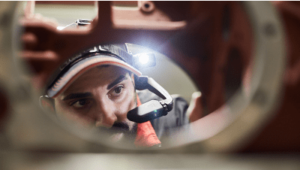What Are the Main Types of Connected Worker Technology?
Connected Worker is revolutionizing companies in a range of industries by helping frontline workers to seamlessly access data and collaborate with team members while in the field. With Connected Worker, companies can transfer knowledge, accelerate processes, cut costs, increase worker safety, and access real-time data.
A Connected Worker solution is made up of multiple pieces of hardware and software that work together to allow for two-way communication and data transmission. Parts of the Connected Worker solution can be customized for use cases in specific industries and businesses.
Here’s an overview of the main types of Connected Worker technology.
Wearables
 The wearable device consists of a headset that can be mounted on any type of headgear using a headband or utility strap. For example, the device can be mounted on a construction worker’s hard hat, an automotive service technician’s cap, or a surgeon’s head covering.
The wearable device consists of a headset that can be mounted on any type of headgear using a headband or utility strap. For example, the device can be mounted on a construction worker’s hard hat, an automotive service technician’s cap, or a surgeon’s head covering.
The headset is equipped with two-way audio and visual communication. A camera allows for video capture, as well as the live sharing of the worker’s viewpoint. Through the wearable device, the worker can view dashboards, schemas, or information from the company’s data center. Audio and video communication empower the worker to access not only company data but also tribal knowledge that can be gained only through interactions with experienced coworkers.
Microphones and a speaker built into the headset enable the worker to communicate remotely with fellow employees and supervisors back at the company headquarters, as well as subject matter experts located anywhere in the world. The microphones also allow the worker to perform hands-free voice commands. The microphones and speaker have noise cancellation capabilities that can be toggled on and off for crystal clear communication or for troubleshooting background noises in a noisy industrial environment.
Software
The software in Connected Worker is the key to its adaptability. The software can be customized according to your company’s needs.
Connected Worker has many proven use cases in industries such as oil and gas, automotive, healthcare, and manufacturing. Some use cases include real-time remote assistance, digital workflows for step-by-step processes, and knowledge transfer/worker training. Connected Worker software can plan or automate tasks, as well as harness the power of artificial intelligence for decision making.
Connectivity
Connectivity is what links all these technologies into one solution. To share information and collaborate, frontline workers must be connected using a robust and reliable network with ample bandwidth. The network allows remote workers to access real-time information, receive and send video, and communicate with coworkers while still in the field. If wireless is not available, LTE or mobile hotspots can be leveraged as well.
Seeing is believing. Schedule a demo of CBT Connected Worker and imagine the possibilities for your business.
Bringing Connected Worker Technology Together
Uniting all the hardware and software elements in a Connected Worker solution requires specialized expertise. Connected Worker depends on information technology and operational technology (IT/OT) convergence.
Some technology providers and system integrators may be able to help your company implement a Connected Worker solution, but they may not be capable of creating a supporting architecture or customizing it for your requirements.
At CBT, we have the IT/OT convergence know-how necessary to create, implement, and support the Connected Worker solution that is ideal for your business. We have a successful track record of customizing Connected Worker solutions for companies in a wide range of industries. To see how our solutions are put together and to explore potential use cases, check out our virtual overview.
